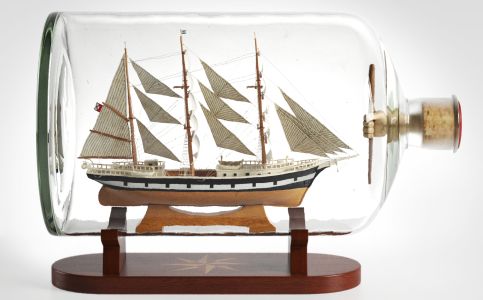 A Facebook video by my friend Frank Hanavan showing him inserting a ship in a bottle (after the page break) got me thinking about, well, ships in bottles. When, where and why did sailors start putting ships in bottles? After looking into the history of ships in bottles (or SIBs, as the aficionados refer to them), I don’t claim to have all, or even most, of the answers but I have come across some interesting lore. An updated repost.
A Facebook video by my friend Frank Hanavan showing him inserting a ship in a bottle (after the page break) got me thinking about, well, ships in bottles. When, where and why did sailors start putting ships in bottles? After looking into the history of ships in bottles (or SIBs, as the aficionados refer to them), I don’t claim to have all, or even most, of the answers but I have come across some interesting lore. An updated repost.
The first mention of objects in bottles dates back to 1719. A German artist, musician and magician, Matthias Buchinger, built models, although not necessarily of ships, inside bottles. He was also well known as an illustrator and engraver, all of which was remarkable given that he was born without arms or legs. He was also quite the lady’s man, having married four times and having at least 14 children by eight women.
As described in History of Ships in Bottles – by Bob de Jongste: The oldest surviving ship in a bottle dates to 1784 and is a Turkish or a Portuguese three-masted warship. It is put in an egg-shaped bottle, which is placed upside down over a wooden stand. It is now part of the collection of the ‘Museum fiir Kunst und Kulturgeschichte der Hansestadt Lubeck’ in Germany.
The oldest SIB in the Netherlands is dated 1795. It is a so-called POON-ship, a one-masted freighter with lee-boards, ranging from 16 to 60 tons. It was also used for regular passenger service. This SIB can be found in the Maritime Museum at Rotterdam.
The SIB became very popular after the fast sailing ships like the clipper were put into service. Consequently most of the antique SIB’s which can be found (very scarce) are dated later than 1840.
To learn more about ships in a bottle, check out The Ships-In-Bottles Association of America (S.I.B.A.A.)
To watch Frank’s artistry, check out the video below:
